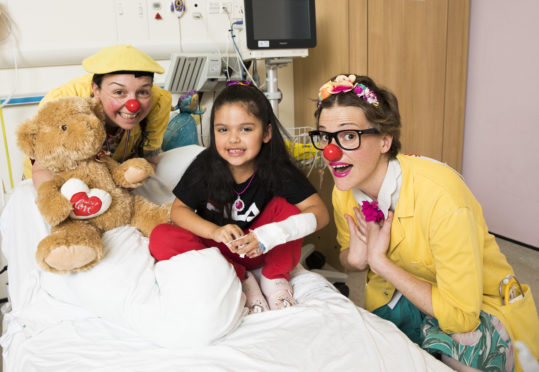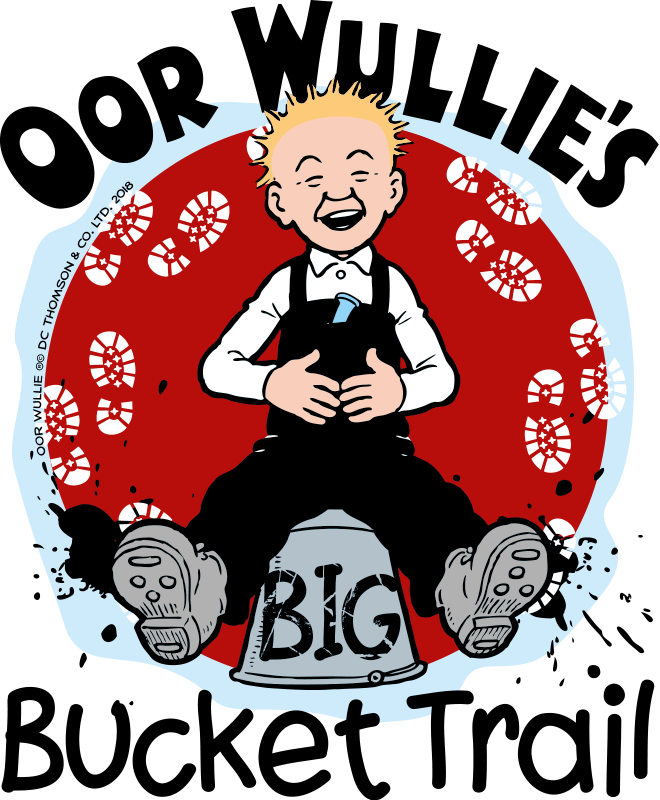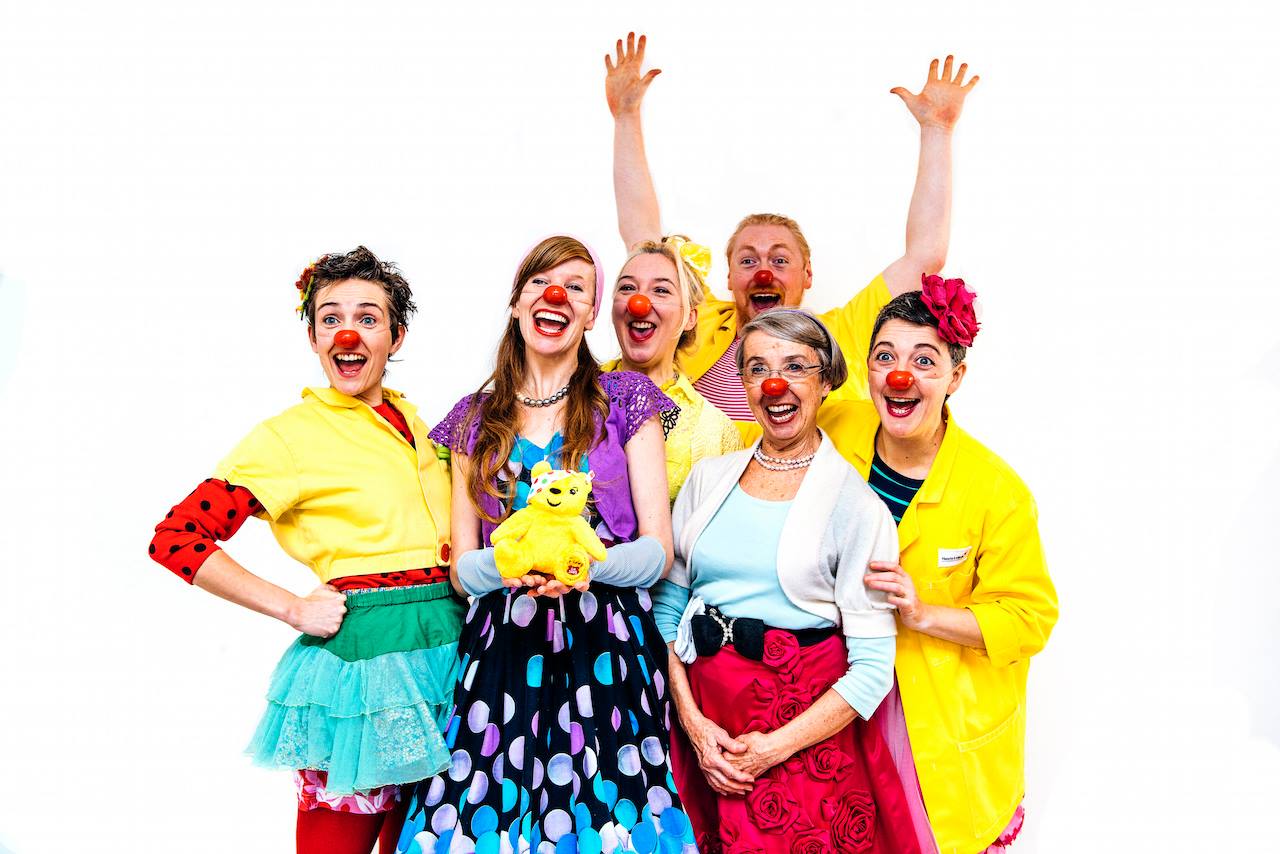
They say laughter is the best medicine. Well, after a visit from the Clowndoctors, little Tamara Demel couldn’t agree more.
Tamara, six, from Clydebank, was admitted to Glasgow’s Royal Hospital for Children on Sunday after suffering a seizure.
“It came completely out of the blue,” mum Heather, 38, said.
“Tamara lay down on the kitchen floor and I thought she was just tired but we soon noticed it was a seizure.
“It lasted about 24 hours so was pretty scary.
“She’s never had any history of being unwell and never been in hospital so it has all been a bit daunting. They’re doing tests so we’re still not sure what caused it.
“But the Clowndoctors certainly cheered her up. I haven’t seen her laugh so hard in ages.”
The Clowndoctors, with their silly red noses and yellow coats, are a ray of sunshine for sick kids in hospital across the country.
They prescribe a dose of fun to young patients in Glasgow, Edinburgh and Aberdeen and bring a welcome distraction from the intensity of illness and treatment.
The scheme is the brainchild of charity Hearts and Minds and is just one of the play programmes supported by Glasgow Children’s Hospital Charity, Edinburgh Children’s Hospital Charity and the ARCHIE Foundation – the beneficiaries of Oor Wullie’s BIG Bucket Trail.

This summer, the campaign fronted by the nation’s favourite son will see at least 150 Wullie statues go on display for families to enjoy before the sculptures are auctioned off to raise funds for the three amazing charities that help care for nearly half a million babies and young children every year.
From June to September, the colourful statues of the spiky-haired scamp – all uniquely designed – will be placed around Glasgow, Edinburgh, Dundee, Aberdeen and Inverness.
The chosen beneficiaries – Glasgow Hospital Children’s Charity, Edinburgh Children’s Hospital Charity and the ARCHIE Foundation – work closely with hospitals, offering invaluable financial support to ensure children get the best possible treatment and support.
Each of the charities funds Clowndoctor visits to the hospitals they support. The Clowndoctors play a critical part in supporting the mental health of many children who spend time in hospital, complementing the outstanding medical care they receive from the NHS.
Clowndoctors come from a range of backgrounds but mainly performing and theatre.
One you might recognise from TV is River City star Carmen Pieraccini, who plays Kelly-Marie Adams in the soap. They visit hospitals, hospices and respite centres across Scotland, entertaining babies, children and young people with short, long-term and sometimes life-limiting conditions.
Each intervention is “made to measure” and improvised and might involve music, singing, magic, puppetry, slapstick or imaginative play. When infection control is required, they can visit children through the window.
Hearts and Minds CEO Michelle Armstrong said: “We believe that laughter is nature’s best medicine, but what we do goes far beyond that.
“We use therapeutic clowning to make a genuine connection with every child we interact with, engaging with the young individual behind the illness.”

Jacob Shaw has spent years following the Clowndoctors around Scotland’s hospitals for sick children.
But they still manage to raise a smile – and lots of giggles – every time they see him.
The seven-year-old, from Macduff, has spina bifida, hydrocephalus and Arnold Chiari Malformation, where the brain pushes down into the spinal canal. Since undergoing his first operation at birth, the youngster has spent much of his life in hospital.
Mum Kirsty said: “From the beginning we were told it was very unlikely Jacob would make his first birthday. It was heartbreaking, but one year passed and then another, and another – and seven years on here we are and he’s still going strong.
“Jacob’s conditions mean he has trouble swallowing and quite often forgets to breathe. It’s fair to say we’ve had some scary moments over the years – but lots of happy ones as well. Every day is a miracle for us. Jacob wasn’t expected to sit up or talk but he has proved everyone wrong.
“He recently started putting words into sentences and three years ago started mainstream school.
“So he’s pretty amazing despite his difficult start in life. Jacob has spent the majority of his seven years in or travelling between the children’s hospitals in Glasgow, Edinburgh and Aberdeen. Many Christmases and birthdays have been spent having treatment.
“But initiatives like the Clowndoctors make it an enjoyable experience.
“The clowns have a way of spreading infectious cheer. They bring laughter which is the best medicine.”

Enjoy the convenience of having The Sunday Post delivered as a digital ePaper straight to your smartphone, tablet or computer.
Subscribe for only £5.49 a month and enjoy all the benefits of the printed paper as a digital replica.
Subscribe